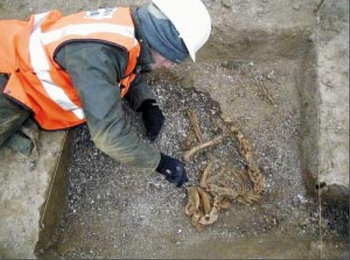Saltwood Tunnel, Kent - Integrated Site Report
Canterbury Archaeological Trust, Wessex Archaeology, 2009. (updated 2017) https://doi.org/10.5284/1044826. How to cite using this DOI
Data copyright © High Speed 1 unless otherwise stated
This work is licensed under the ADS Terms of Use and Access.
Primary contact
Stuart
Foreman
Senior Project Manager
Oxford Archaeology (South)
Janus House
Osney Mead
Oxford
OX2 0ES
UK
Tel: 01865 263800
Fax: 01865 793496
Resource identifiers
- ADS Collection: 2473
- DOI:https://doi.org/10.5284/1044826
- How to cite using this DOI
Introduction

As part of an extensive scheme of archaeological mitigation undertaken prior to construction of the Channel Tunnel Rail Link, Canterbury Archaeological Trust and Wessex Archaeology were commissioned by Rail Link Engineering Limited to carry out a programme of archaeological excavation at Saltwood Tunnel, north of Saltwood, Kent (NGR TR 615345 136940 to TR 616157 136925). A complex multi-period site was revealed, with evidence for ceremonial and funerary land use as well as for settlement and agriculture.
Activity earlier than the Bronze Age was mainly restricted to unstratified or residual flint and pottery, but a group of eight Mesolithic Horsham-type retouched points from a small pit-like feature may date to the 7th millennium BC, and three early Neolithic pits attest to activity, perhaps domestic, in the mid-late 4th millennium BC. In the early Bronze Age a barrow cemetery developed. Five barrows and a flat grave dated to the late 3rd-early 2nd millennium BC.
Limited middle Bronze Age evidence, comprising a cremation burial, a small pit and other occasional finds of Deverel-Rimbury pottery, suggest the cemetery was respected until the late 2nd millennium BC but, in the late Bronze Age, a settlement and field-system were established. Early to middle Iron Age agriculture is also attested by ditches and at least one track or droveway. No contemporary settlement remains were discovered, but an early-middle Iron Age inhumation cemetery and a square enclosure, perhaps a mortuary enclosure, were established at some time between the 8th - 4th centuries BC. A middle Iron Age inhumation grave of 2nd to 4th century BC date also lay near the western end of the site.
Early Romano-British domestic finds abounded at the western end of the excavation, mainly near a sunken trackway and in pits and field-enclosures to either side of it. The quantity and range of finds, and the presence of two small cremation cemeteries, strongly suggest a small rural settlement lay close-by. That this settlement waned after the mid-late 3rd century is inferred from a greatly reduced suite of remains, and from progressive infilling of the sunken trackway. Limited occupation, or at least occasional use of the site, is likely to have continued into the later 4th century.
Early Anglo-Saxon evidence from Saltwood Tunnel is dominated by three separate inhumation cemeteries, each located in the vicinity of a Bronze Age barrow. Seventeen graves were excavated within the eastern cemetery, 59 in the western cemetery and 141 in the central cemetery. Both the eastern and western cemeteries appear to have begun in the early 6th century. The eastern cemetery lasted only for one or two generations, whilst the western cemetery continued well into the 7th century. The central cemetery was established during the late 6th century and continued throughout the 7th century. From the early 6th century onwards there were always two cemeteries in use at the same time. Three early Anglo-Saxon grubenhauser were also identified, all of which lay in the vicinity of the cemeteries and a little to the north of them.
Several early medieval ditches and pits towards the eastern end of the excavation mark the location of a small rural site, probably 10th or 11th century in date. Other medieval and post-medieval pottery was recovered from features and topsoil in the north-western corner of the excavation, where elements of the ancient Romano-British landscape may have been exploited as rectilinear fields, or possibly stock-pens. Remains associated with construction of the Saltwood railway tunnel in the early 1840s and relating to the presence of a military barracks in the earlier 20th century were recorded, but are not discussed in detail.
The fieldwork events covered by this report are:
- Stone Farm Bridleway (ARC SFB99) - Excavation
- North of Saltwood Tunnel (ARC SLT98) - Excavation
- North of Saltwood Tunnel (ARC SLT98C) - Excavation
- North of Saltwood Tunnel (ARC SLT99) - Excavation







